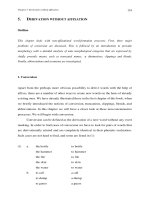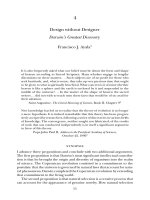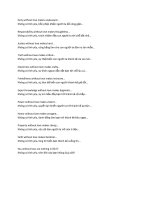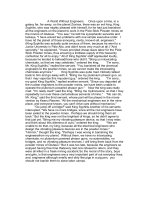Derivation without affixation
Bạn đang xem bản rút gọn của tài liệu. Xem và tải ngay bản đầy đủ của tài liệu tại đây (140.07 KB, 35 trang )
Chapter 5: Derivation without affixation
134
5. DERIVATION WITHOUT AFFIXATION
Outline
This chapter deals with non-affixational word-formation processes. First, three major
problems of conversion are discussed. This is followed by an introduction to prosodic
morphology with a detailed analysis of some morphological categories that are expressed by
chiefly prosodic means, such as truncated names, -y diminutives, clippings and blends.
Finally, abbreviations and acronyms are investigated.
1. Conversion
Apart from the perhaps more obvious possibility to derive words with the help of
affixes, there are a number of other ways to create new words on the basis of already
existing ones. We have already illustrated these in the first chapter of this book, when
we briefly introduced the notions of conversion, truncations, clippings, blends, and
abbreviations. In this chapter we will have a closer look at these non-concatenative
processes. We will begin with conversion.
Conversion can be defined as the derivation of a new word without any overt
marking. In order to find cases of conversion we have to look for pairs of words that
are derivationally related and are completely identical in their phonetic realization.
Such cases are not hard to find, and some are listed in (1):
(1) a. the bottle to bottle
the hammer to hammer
the file to file
the skin to skin
the water to water
b. to call a call
to dump a dump
to guess a guess
Chapter 5: Derivation without affixation
135
to jump a jump
to spy a spy
c. better to better
empty to empty
hip to hip
open to open
rustproof to rustproof
d. poor the poor
rich the rich
well-fed the well-fed
blind the blind
sublime the sublime
As can be seen from the organization of the data, different types of conversion can be
distinguished, in particular noun to verb (1a), verb to noun (1b), adjective to verb (1c)
and adjective to noun (1d). Other types can also be found, but seem to be more
marginal (e.g. the use of prepositions as verbs, as in to down the can). Conversion
raises three major theoretical problems that we will discuss in the following: the
problem of directionality, the problem of zero-morphs and the problem of the
morphology-syntax boundary.
1.1. The directionality of conversion
The first problem is the directionality of conversion. We have simply assumed, but
not shown, that in (1a) it is the verb that is derived from the noun and not the noun
that is derived from the verb. For the data in (1b) we have assumed the opposite,
namely that the verb is basic and the noun derived. Similar assumptions have been
made for the data in (1c) and (1d). But how can these assumptions be justified or
substantiated? There are four possible ways of determining the directionality of
conversion.
Chapter 5: Derivation without affixation
136
The first would be to look at the history of the language and see which word
was first. While this may work nicely with many words, there are other word pairs
where the historical relationship would go against our present-day intuition. For
example, most speakers would probably say that the verb to crowd is most probably
derived from the noun crowd. However, according to the OED, historically the verb
was first. In Old English, the verb crûdan meant ‘to press, hasten, drive’, with its first
attestation in 937 A.D.. The primary meaning ‘to press’ was later specialized to refer
to the compression of multitudes. Only then (in the 16th century) was the verb
converted into a noun denoting a compressed mass of people or things, a meaning
that was later broadened to denote any mass of people. This example shows that
simply looking at earliest attestations does not solve the directionality problem,
because complex semantic changes may overwrite the original direction of
conversion. Similar arguments hold for moan, which was first attested in 1225 as a
noun, and only later, in the 16th century, this noun was converted into a verb (see
OED, s.v. moan). Today’s meaning of moan is perhaps best described as ‘the act of
moaning’, which shows that for present-day speakers the noun depends on the verb
for its interpretation and not vice versa.
The example of moan already indicates a more promising way of determining
the direction of conversion, namely investigating the semantic complexity of the two
words in question. In general, derived words are semantically more complex than
their bases, since affixes normally add a certain meaning to the meaning of the base.
A parallel reasoning can be applied to conversion: the derived (i.e. converted) word
should be semantically more complex than the base word from which it is derived.
Thus, if one member of the pair can be analyzed as being semantically more complex
than or as being semantically dependent on the other member, we have good
evidence that the dependent member is derived from the other form. Consider four
of the examples in (1): the meaning of the verb bottle is ‘to fill into a bottle’, the
meaning of the noun call is ‘the act of calling’, the meaning of the verb to better is ‘to
make or become better’, and the meaning of noun poor is ’poor people (as a class)’. In
all four cases the second member of the pair is semantically more complex than the
first member and depends in its interpretation on the latter. Speaking in terms of
Chapter 5: Derivation without affixation
137
concepts, the verb to bottle requires the existence of the concept of a bottle. Without a
bottle there is no bottling.
The semantic dependency between base and derived word is chiefly
responsible for the intuitive feeling that the words on the right in (1) are derived on
the basis of the words on the left, and not vice versa.
But historical and semantic information are not the only clue to solve the
directionality problem. Base form and derived form also often differ in formal
properties. Consider, for example, the data in (2):
(2) present tense past tense meaning
ring ringed ‘provide with a ring’
ring rang *‘provide with a ring’
wing winged/*wang/*wung ‘provide with wings’
grandstand grandstanded/*grandstood ‘provide with a
grandstand’
The past tense forms of the converted verbs are all regular, although there is in
principle the possibility of irregular inflection. The past tense form rang cannot mean
‘provide with a ring’, the past tense form of to wing cannot be formed in analogy to
similar-sounding verbs like (sing, ring, or sting), and the past tense form of to
grandstand must also be regular. Why should this be so? The reason for this state of
affairs lies in the nature of irregular inflection. Irregularly inflected words like went,
took or brought must by learned by children (and second language learners) item by
item, i.e. by storing every irregular form in the lexicon. If for a given word there is no
irregular form stored in the lexicon, this form will be inflected according to the
regular inflectional patterns. This is the reason why children often say things like
goed and taked, and why newly created words, which do not yet have a stored entry
in the mental lexicon, are inflected regularly.
Now, if we can state that converted verbs in general must be regularly
inflected, we can make an argument concerning the directionality of conversion
based on the inflectional behavior: if we find a homonymous verb-noun pair which is
a potential case of comversion, and one of the words is irregularly inflected, this is a
Chapter 5: Derivation without affixation
138
strong indication that the regularly inflected form is derived from the irregularly
inflected form. For instance, the irregular inflectional behavior of verbs like to drink,
to hit, to shake, or to sleep is a strong argument for the deverbal nature of the nouns
drink, hit, shake and sleep. In sum, the inflectional behavior of forms can give evidence
for a particular direction of conversion.
Another formal property that comes to mind when thinking about conversion
is stress. Take a look at (3):
(3) a. to tormént - a tórment
to permít - a pérmit
to constrúct - a cónstruct
to extráct - an éxtract
to abstráct - an ábstract
b. to gèt awáy - a gét-awày
to lèt dówn - a lét-dòwn
to pùll dówn - a púll-dòwn
to pùsh úp - a púsh-up
to wàlk òver - a wálk-òver
The data in (3) show pairs of verbs (on the left) and nouns (on the right) which can be
analyzed as standing in a derivational relationship. Based on semantic
considerations, we can state that these are all cases of deverbal nouns. From a formal
perspective these pairs are also interesting because the two members differ in one
formal property, their stress pattern. When spelled without the accents indicating
stresses, there is no visible marking, but when pronounced, there is a clear difference
between the verbs and the nouns: the verbs in (3a) have primary stress on their last
syllable, while the related nouns have stress on the first syllable. Similarly, the
phrasal verbs in (3b) have primary stress on the preposition, while the related nouns
have primary stress on the first element. Thus, in all those cases where we observe a
stress-shift, we have a good argument to say that we are dealing with derived nouns.
Note, however, that the above examples are not clear cases of conversion, because
the relationship between the pairs is marked overtly, even though this marking is
Chapter 5: Derivation without affixation
139
done not by an affix, but by a prosodic property. But even if we do not regard pairs
such as those in (3) as instances of conversion, we still would have to account for the
derivational relationship and find out which member of the pair is basic and which
one is derived. What these examples show independently of their being classified as
instances of conversion or not is that formal properties can be adduced to
substantiate other, in this case semantic, criteria for the directionality of derivation,
even in the absence of affixes.
The last property relevant for the determination of directionality is frequency
of occurrence. In general, there is a strong tendency for derived words being less
frequently used than their base words. For example, it has been shown in Plag (2002)
that in a random sample of 92 -able derivatives taken from the BNC only 4
derivatives were more frequent than their base words, whereas all other -able
derivatives in the sample were less frequent than their bases. The same was shown
for a sample of -ize derivatives, where only 11 out of 102 derivatives were more
frequent than their base words. The simple reason for these facts is again semantics.
being semantically more complex, derived words have a narrower range of meaning,
to the effect that they can not be used in as many contexts as their base words. With
regard to conversion, we would therefore expect that by and large the derived word
is the less frequent one. For the directionality question this means that, for example,
if the noun water is more frequent than the verb to water (which indeed is the case),
this is an indication that the verb is derived from the noun. In the case of drink, the
verb is more frequent, which supports our above arguments that the verb is basic
and the noun derived.
In sum, we have seen that there is a whole range of criteria by which the
directionality of conversion can be established. Nevertheless, one may occasionally
end up with difficult cases. For example, forms such as love (the noun) and love (the
verb) are hard to decide upon. Both are current since Old English times, and none of
them seems to be semantically primary. Thus to love could be paraphrased as ‘being
in a state of love’, indicating that it may be a denominal derivative. However, the
opposite direction can also be argued for, since the noun could be paraphrased as
‘state of loving’, which would make the verb primary. The non-syntactic criteria
discussed above do not lead to a clear result either. Although such equivocal cases do
Chapter 5: Derivation without affixation
140
occur, it seems that for the vast majority of cases it is possible to establish the
direction of conversion.
Let us turn to the second theoretical problem raised by conversion, the
problem of zero.
1.2. Conversion or zero-affixation?
Although we have argued in chapter 1, section 2, that in principle the existence of
zero forms should not be rejected entirely, the question remains in which particular
cases it is justified to postulate a zero form. Most morphologists usually think that a
zero form is justified only in those cases where there is also an overt (i.e. non-zero)
form that expresses exactly the same meaning or function (cf. e.g. Sanders 1988:160-
161). This constraint has also been called the overt analogue criterion. The obvious
question now is whether there is such an overt analogue in the cases of conversion
introduced above.
This means that for each type of conversion (noun to verb, verb to noun,
adjective to verb, adjective to noun) we would have to find at least one affix that
expresses exactly the same range of meanings as conversion. If so, we can safely
assume the existence of a zero-affix, if not, we have to reject it. You might wonder
why such a decision is necessary anyway. After all, in both cases, both conversion
and zero-affixation would fulfill the same function, i.e. do their job properly. That is
of course true, but if we extend our - so far - narrow descriptive perspective beyond
the phenomenon of conversion into the realm of general morphological theory this
question becomes an important one. Thus, there are theories that claim that all
derivational processes, i.e. overt affixation, conversion, truncation, ablaut, and all
other kinds of formal morphological marking, are in fact affixational (e.g. . Such an
assumption has the advantage that the morphological apparatus is reduced to one
central mechanism (i.e. affixation) and all other seemingly different mechanisms
have no theoretical status and are pure surface phenomena. This kind of theory is
very elegant, but together with this elegance we buy the necessity to provide an
affixational analysis for all processes that - at least on the surface - do not have an
Chapter 5: Derivation without affixation
141
affix. And if we failed in doing so, the theory that all morphology is essentially and
exclusively affixational would have to be rejected. Thus, showing that there is in fact
no zero-affix would seriously challenge this kind of theory.
Let us return to the facts to see whether the overt analogue criterion holds,
starting with conversion into verbs. The crucial question is whether there is a verb-
deriving affix that has precisely the same meaning as our putative zero-affix. In Plag
(1999) I have argued that this is not the case and that the overt suffixes -ate, -ify, and -
ize express much more restricted ranges of meanings than conversion. For example,
in 20th century neologisms, the following types of meaning of converted verbs can be
discerned:
(4) type of meaning paraphrase example
locative ‘put (in)to X’ jail
ornative ‘provide with X’ staff
causative ‘make (more) X’ yellow
resultative ‘make into X’ bundle
inchoative ‘become X’ cool
performative ‘perform X’ counterattack
similative ‘act like X’ chauffeur, pelican
instrumental ‘use X’ hammer
privative ‘remove X’ bark
stative ‘be X’ hostess
In addition to the meanings in (4), more idiosyncratic meanings can also be observed,
such as to eel, which can mean ‘fish for eel’ or ‘to move ... like an eel’, or to premature,
which is recorded as having the meaning ‘Of a shell or other projectile: to explode
prematurely’, or to crew can mean ‘act as a (member of a) crew’ or ‘assign to a crew’.
None of the overt verb-deriving affixes of English can express such a wide range of
meanings (see again the discussion of the verb-deriving suffixes in section 4.2. of the
preceding chapter), so that on the basis of this analysis we have to conclude that the
overt analogue criterion is not met. Hence there is no basis for the assumption of a
zero affix.
Chapter 5: Derivation without affixation
142
To test the overt analogue criterion with verb-to-noun conversion, we have to
compare the meaning of overt suffixes like -ation, -al, -ing, -ment, -ing etc. with
converted nouns. This is not an easy task at all because action nouns tend to be
polysemous. Although in many cases there seems to be no clear semantic difference
between overtly suffixed nouns and converted nouns, Cetnarowska (1993:113) has
shown that there are at least two remarkable systematic differences between nouns
referring to actions derived by -ing and converted nouns (e.g. drawing vs. draw,
beating vs. beat). First, when the base word is a transitive verb, the suffixed noun can
be related to all senses of the verb, while the converted noun relates only to one sense
of the base word. Thus drawing refers to any activity of drawing, whereas draw is
restricted in its reference to the drawing of cards or lots. Secondly, verbs that can be
used transitively and intransitively exhibit different effects under nominalization by
suffixation or conversion. The suffixed nominalization will be related to the transitive
usage of the verb, while the conversion will be related to the intransitive usage. Thus,
we say the beating of the prisoners but the beat of my heart. These systematic differences
suggest that verb-to-noun conversion and overt nominal suffixation are not
semantically identical and that they can therefore not be regarded as overt analogues.
With regard to adjective-to-noun conversion we can observe that there is no
overt analogue in sight. There are suffixes that derive nouns denoting collectivities
similar to the nouns in (1d) (-dom, and -hood in particular, e.g. christiandom see chapter
4, section 4.1.), but these suffixes are strictly denominal and are therefore not possible
analogues. And de-adjectival suffixes such as -ness or -ity do not produce the same
semantic effect as conversion, because they derive nouns denoting states or
properties, but not collective entities (see chapter 4, section 4.1. for details).
Finally, adjective-to-verb conversion does equally not present a clear case of
zero-derivation. Derivatives like to young (‘to present the apparently younger side’,
OED) show that the range of meaning of de-adjectival converted verbs is larger than
the strictly and exclusively causative or inchoative interpretations (‘make (more) X’
or ‘become X’) of overtly suffixed de-adjectival verbs (see again chapter 4, section 4.2.
for more details on verbal suffixes).
Chapter 5: Derivation without affixation
143
In sum, the application of the overt analogue criterion seems to give evidence
against the assumption of zero-derivation and in favor of non-affixational
conversion.
We may now turn to the third major theoretical problem involved in the
analysis of conversion, that of the boundary between syntax and morphology.
1.3. Conversion: syntactic or morphological?
So far, we have tacitly assumed that conversion is a morphological, i.e. lexical,
process. However, one could also argue that conversion is a purely syntactic
mechanism. In other words, conversion could be defined as the use of a word with a
given syntactic category in a syntactic position that it normally does not occupy. And
if it appears in such a position, it takes on the properties of those items that usually
occupy this position. Consider, for example, the following sentences:
(5) a. James watered the plants every other day.
b. Jenny wintered in Spain.
We could argue that the verbs water and winter are not derived by a morphological
process, but simply by putting them into a verbal slot in the sentences (5a) and (5b),
which would be a syntactic, not a morphological operation.
Such a view creates however new problems. Usually it is assumed that words
must have a clear category specification because such information is necessary for the
application of syntactic rules. For example, in order to construct a well-formed
English sentence we must know which word is an article, a noun, an auxiliary, a verb
etc.´, so that we can place them in the right order. Thus the lion will sleep in a cage is a
grammatical sentence, whereas sleep cage the in will lion a is ungrammatical, because
articles must precede their nouns, the auxiliary will must precede the verb sleep, etc.
Such rules make crucial reference to the part-of-speech of words and if this category
information did not exist or could be easily ignored in the application of syntactic
Chapter 5: Derivation without affixation
144
rules, we would easily end up with ill-formed sentences, in which verbs occur in the
positions of nouns, articles in the position of verbs, etc.
Some proponents of a syntactic view of conversion (e.g. Farrell 2001) have
argued that lexical category information may be underspecified, so that full
specification is achieved only when the word appears in a specific syntactic context.
For example, the word hammer could be argued to be semantically determined only
in such a way that it can refer to anything in connection with such a tool. In a
nominal position, as in the hammer, the word hammer receives a nominal
interpretation (‘a tool for hammering’), while in a verbal slot (as in She hammered the
metal flat), the word hammer receives a verbal interpretation (‘action of hammering’).
How can this issue be decided? The best way to solve this problem is to see
what distinguishes in general syntactic processes from morphological ones, and then
look again at conversion and see which properties (syntactic or lexical-
morphological) hold. Such an approach is confronted with the problem of
determining the general properties of syntactic rules or processes. This is a serious
problem because there are many different syntactic theories which have very
different views on this. For example, many people will say that syntactic rules in
general do not change the syntactic category of a word, but need to know the
category of a verb in order to be able to treat the word accordingly. Thus, in English
there is the syntactic rule that articles precede adjectives which in turn precede nouns
(as in the clever student), so that, in order to serialize the words correctly, the rule
must have access to the category information of the words, but cannot change this
information. In this sense, we would have a seemingly clear criterion that would tell
us that conversion is non-syntactic. However, in a different theory of syntax, we
would probably say that there is a syntactic rule which says that adjectives can
generally be used in syntactic positions reserved for nouns, if they are preceded by
the definite article the, as for example in the rich, or the obvious. This would have the
effect that a syntactic rule practically changes the syntactic category of these
adjectives. We do not want to argue in this book for or against certain theories of
syntax, but there is one (more or less) theory-independent argument that can help to
solve the problem of syntax-morphology boundary raised by conversion.
Chapter 5: Derivation without affixation
145
The most important property that distinguishes syntactic rules and entities
from morphological ones is the idiosyncrasies of morphological formations. Complex
words can display all kinds of exceptional properties, whereas syntactic patterns and
their interpretations tend to be rather exceptionless. Applying this idea to
conversion, it seems that with regard to converted verbs, idiosyncratic meanings and
lexical gaps seem to be rather common, which indicates their lexical, non-syntactic,
nature. Coming back to example (5b), we can observe that to winter is possible, but
that the analogous forms to spring or to autumn seem to be utterly strange.
Furthermore, many unclear restrictions hold as to which kinds of nouns can be
converted into verbs. Many nouns can only take overt suffixes, and the reason seems
to be often a morphological one. For example, most complex nouns (e.g. derivatives
in -ness, -ity, -ation, -ment etc.) cannot occur in syntactic positions normally reserved
for verbs (cf. e.g. *Jane couriousnesses every day). Such restrictions are extremely
uncommon (to put it mildly) in syntax. Syntactic rules usually check the syntactic
category of a word, but not its internal derivational morphology, i.e. what kinds of
derivational affixes the word has. In view of these arguments it makes sense to
conceive of conversion as a lexical, i.e. morphological process, and not as a syntactic
one.
To summarize our discussion of the three major problems of conversion, we
have seen that the directionality problem can be solved by combining historical,
semantic, formal and frequential evidence, the problem of zero can be solved by
strictly applying the overt analogue criterion, and the morphology-syntax boundary
problem can be solved by adducing considerations on the nature of lexical rules.
2. Prosodic morphology
As already introduced in chapter 4, prosodic morphology deals with the interaction
of morphological and prosodic information in determining the structure of complex
words. In section 3 of that chapter, we have discussed cases of phonology-
morphology interaction that involved suffixation. We saw, among other things, that
the attachment of a certain suffix can be responsible for a specific stress pattern that
Chapter 5: Derivation without affixation
146
holds for all members of the pertinent morphological category. For instance, all
nouns in -ity carry primary stress on the antepenultimate syllable, all -ic adjectives
have stress on the penult, and all nouns in -ee have stress on the suffix. In other
words, even in suffixation we find that the structure of derivatives is determined by
an interaction of morphology and prosody. The term ‘prosodic morphology’ is,
however, usually reserved for those cases where the relevant category is expressed
predominantly or exclusively through prosody, which is certainly not the case with
the suffixes just mentioned. We will discuss two kinds of word-formation processes
in English where prosody plays a prominent role, truncations and blends.
2.1. Truncations: Truncated names, -y diminutives and clippings
Truncation is a process in which the relationship between a derived word and its
base is expressed by the lack of phonetic material in the derived word. Examples
were already given in chapter 1 and are repeated here for convenience:
(6) a. Ron (← Aaron) b. condo (← condominium)
Liz (← Elizabeth) demo (← demonstration)
Mike (← Michael) disco (← discotheque)
Trish (← Patricia) lab (← laboratory)
The examples in (7) below involve suffixation by -y (orthographic variants of which
are -ie and sometimes -ee), but their form seems also to be heavily influenced by
truncation, which is the reason why we treat them in this chapter and not in the
section on suffixation in the previous chapter.
(7) Mandy (←Amanda)
Andy (← Andrew)
Charlie (← Charles)
Patty (← Patricia)
Robbie (← Roberta)
Chapter 5: Derivation without affixation
147
Given that all three types of formation are rather common and comparatively
productive, the obvious question is how such words are formed, and what kinds of
rules or restrictions are at work.
In previous work on these categories such forms are usually regarded as
highly idiosyncratic, and have been argued as being outside grammatical
morphology (cf. our discussion of infixation in the previous chapter). However, we
will shortly see that such claims are not really justified. Truncations in English are
highly systematic, and their systematicity shows that the knowledge about the
structural properties of these categories must be part of the morphological
competence of the speakers. We will discuss each type of truncation in more detail.
Truncated names can be distinguished from -y diminutives both semantically
and formally. Truncated names (and clippings like lab) are used to express
familiarity. Thus, truncations are normally used by people who feel familiar with the
person referred to and who want to express this familiarity overtly. Diminutives
such as sweety or Frannie express not only familiarity, but also (usually positive)
affection towards the person or thing referred to. Let us turn to the form of name
truncations.
Consider the following data and take a moment to think about their prosodic
properties, both in terms of their own structure, but also in terms of how this
structure is related to that of their respective base words. The data and analysis are
taken from Lappe (2003):









